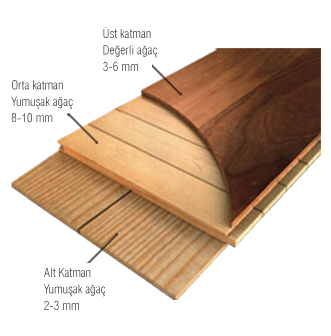The lamine obtained from 100% of the wood is a completely natural material.
Due to this feature, it is heavily demanded; reflects the natural texture of the wood to the environment in which it is located.
Lamine which provides comfort to its users in terms of ease of use and cleaning; it is resistant, the rate of any shape changes or dilation between plates are low.
Lamine; has suitable construction for adhered and floating flooring system.
The lamine, which is used with complacency in the floor heating systems, is sensitive to sound insulation.
Lamine, which suits up scraping and polish processes on its surface; has various colour and texture alternatives such as oak, beechen, dusi, iroko, sapelli and maple.
Wood consists of several different layers in the lamine.
In the top layer, it is understood the type of wood used.

In this material, ranging from 3 to 4 mm, precious wood is always used in the top layer.
All layers are laid opposite to each other in the lamine.
The material obtained by pressing the wood in three different ways; leads to minimally wear off the layers placed in different directions and to be less affected by external factors such as weather conditions and humidity.
The top layer: This layer, generally ranging from 3 to 6 mm, is named according to the type of wood used.
This layer gained by using special varnishes; is produced as plank (single tree), 2 strips (two-wood pressing) and 3 strips (three-wood pressing).
Middle layer: This layer is attained by pressing any wood at a ninety degree angle horizontally or vertically.
This layer which is produced at a standard measure as to 8 to 10 mm thickness is passed special kiln drying process in order to support the top layer.
The bottom layer: This layer, mostly fixed to the middle layer by pressing horizontally, is made from as hard wood as possible in order to provide ground and plate stability.